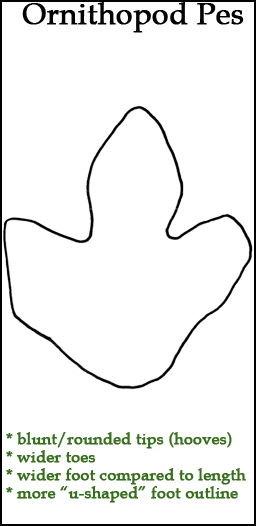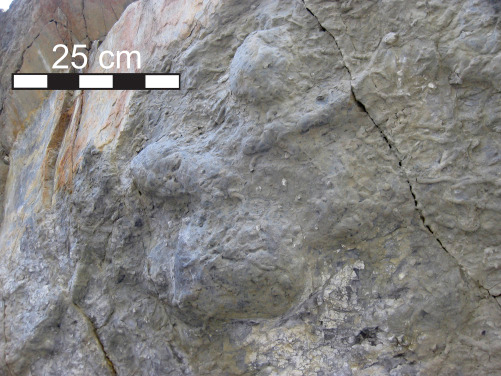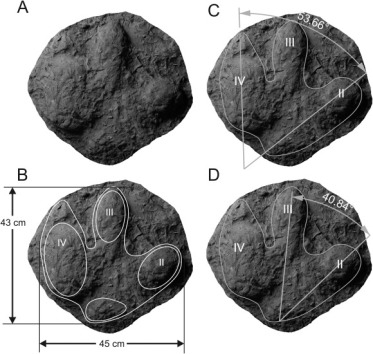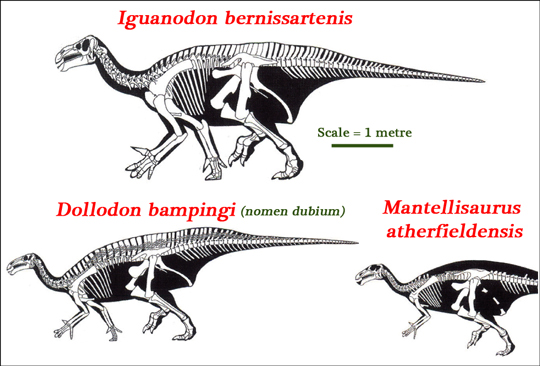Evidence of Iguanodontids from Early Cretaceous Alberta
Fossilised Footprint Hints at Iguanodontids Present in Early Cretaceous Alberta
The iguanodontids were one of the most successful groups of ornithischian dinosaurs to evolve. These herbivores with their batteries of teeth and the ability to chew their food attained a near global distribution by the late Early Cretaceous. However, despite numerous body fossils representing several genera being found in Upper Jurassic and Lower Cretaceous strata of the western United States, their fossilised remains have never been recorded from western Canada.
Palaeontologists have suspected that iguanodontids were present in western Canada but the fossil evidence was lacking – until now that is. Analysis of a single dinosaur footprint suggests that these plant-eating dinosaurs were roaming south-western Alberta during the Early Cretaceous, the footprint, if interpreted correctly, helps to fill a gap in western Canada’s dinosaur fossil record.
Track Indicates Iguanodontids Present in Western Canada
Picture credit: Royal Tyrrell Museum (Drumheller)
The picture shows the fossilised dinosaur footprint, preserved as a natural cast on the underside of a sandstone ledge from a site in south-western Alberta. For Dr Donald Henderson (Curator of Dinosaurs, at the Royal Tyrrell Museum), this single track has enough similarities to iguanodontid tracks found elsewhere in the world, to conclude that this print does indicate, that as expected, these types of dinosaur were living in the Early Cretaceous of western Canada.
Writing in the journal “Cretaceous Research”, Dr Henderson cites this fossil as the first evidence of iguanodontids in Alberta and asserts that this fossil is helping to clarify the distribution of iguanodontian dinosaurs.
Those Successful Iguanodontians
The Iguanodontia is a clade of ornithopod dinosaurs that evolved in the Late Jurassic, diversified into many different families and had an almost global distribution. They thrived in the Early Cretaceous and some genera survived until the end of the Cretaceous. Within the Iguanodontia there are several sub-clades. For example, the Ankylopollexia “stiff thumbs”, a clade of iguanodontians which are considered to be more derived than other members of the Iguanodontia and they are united by a common feature, that of having a conical thumb claw. Members of the Ankylopollexia include Camptosaurus from the Upper Jurassic of the western United States and the Iguanodon genera including Iguanodon bernissartensis from the Early Cretaceous of Europe.
Most large iguanodontids were facultative bipeds and they produced characteristic tracks, with substantial, tri-dactyl hind footprints, with blunt tips to the toes (see illustration below).
A Line Drawing of the Hind Footprint of a Typical Large Ornithopod Dinosaur (Iguanodontian)

Line drawing of the hind footprint of a large Ornithopod (iguanodontid). Picture credit: Everything Dinosaur.
Picture credit: Everything Dinosaur
Iguanodontids and the Ankylopollexia
The Ankylopollexia can be further sub-divided into the camptosaurs and the Styracosterna, which contains the hadrosaurids (duck-billed dinosaurs), that went onto dominate many terrestrial habitats in the Late Cretaceous.
Dr Henderson compared the track with numerous iguanodontid specimens and concluded that this footprint was most likely made by an iguanodontid. The fossilised footprint comes from the Gladstone Formation (south-western Alberta), and the host rock is dated to the Early Cretaceous (Barremian faunal stage), a time when these types of dinosaurs were evolving rapidly and diversifying.
Dr Henderson Identified Common Characteristics Between the Tracks in the Study
Picture credit: Royal Tyrrell Museum
This is an exciting development, as it helps to fill in a gap in Alberta’s dinosaur fossil record. Dr Henderson suggests that the lack of iguanodontid fossil material might be because older rock layers are found in areas which are in relatively inaccessible, remote locations, that are heavily forested and often deeply buried under younger rocks. The Royal Tyrrell Museum staff member believes that other iguanodontid fossil material including body fossils are likely to found in future.
Skeletal Comparisons of Three Typical Iguanodontids (Ankylopollexians – family Iguanodontidae)
The scientific paper: “The First Evidence of Iguanodontids (Dinosauria, Ornithischia) in Alberta, Canada: A Fossil Footprint from the Early Cretaceous” published in April 2017 in the journal “Cretaceous Research”.
Visit the Everything Dinosaur website: Everything Dinosaur.




